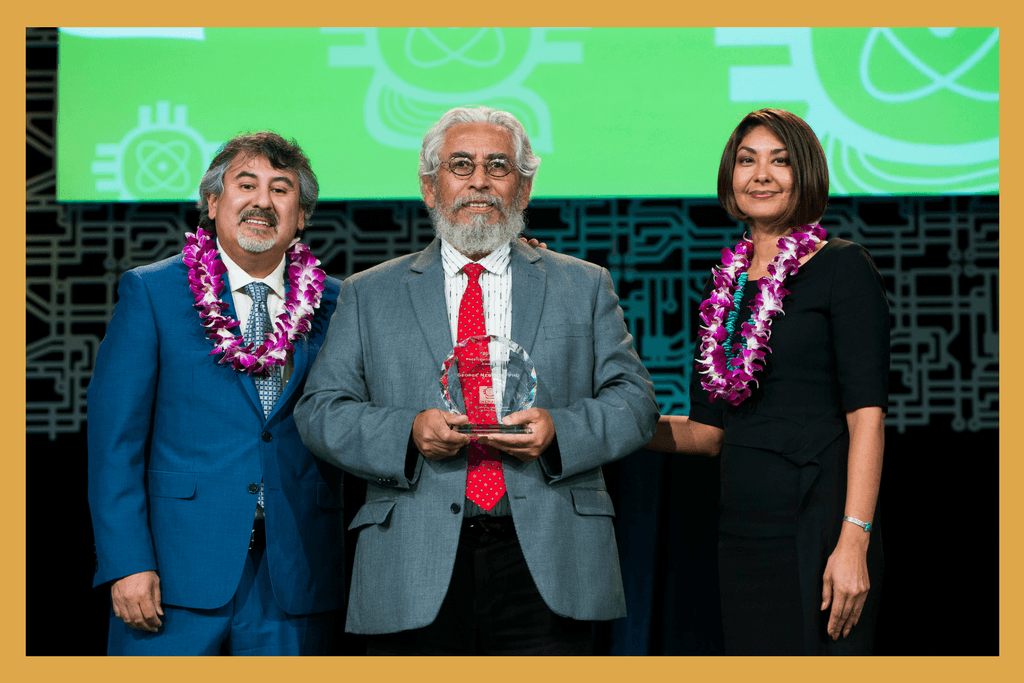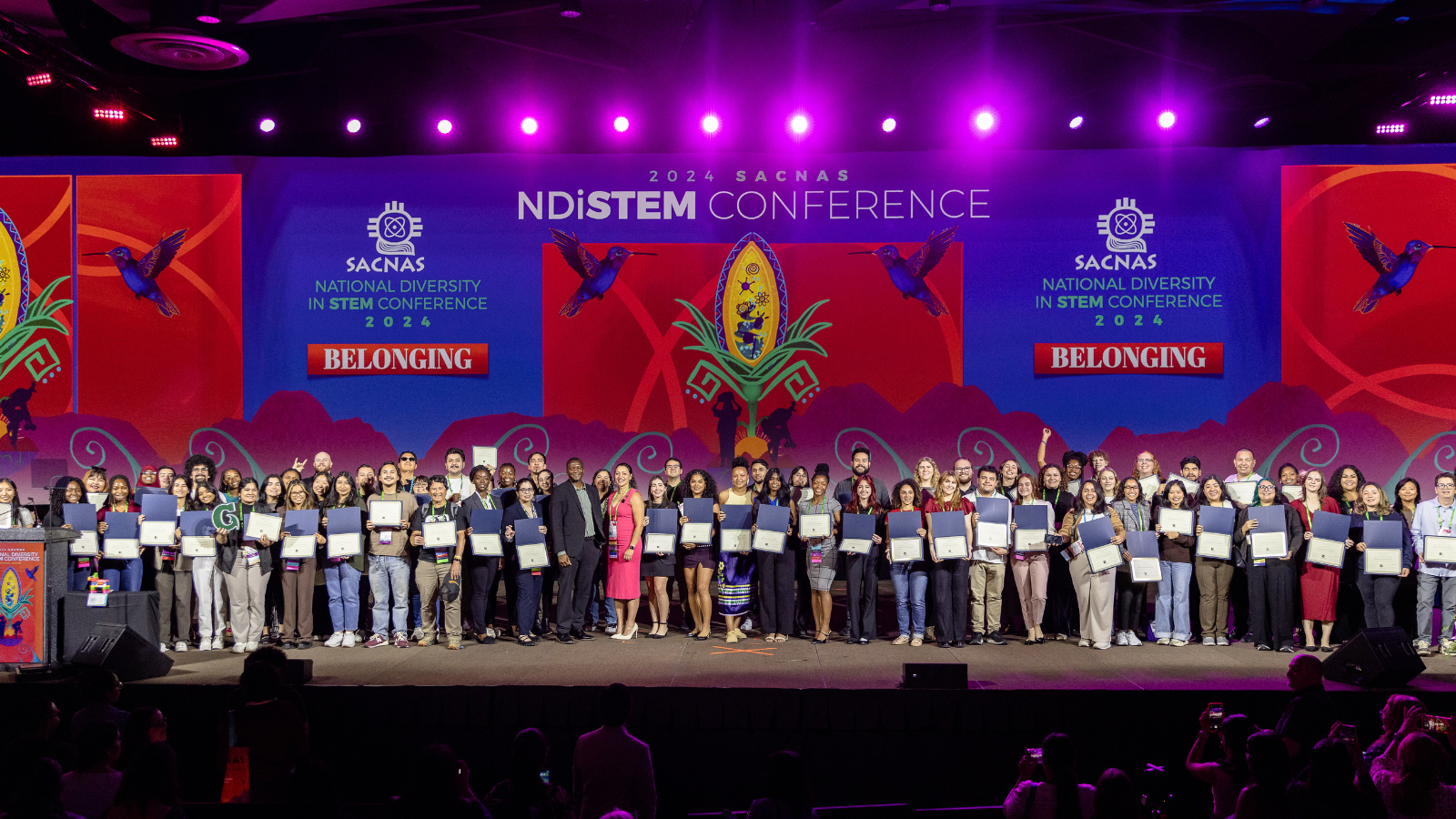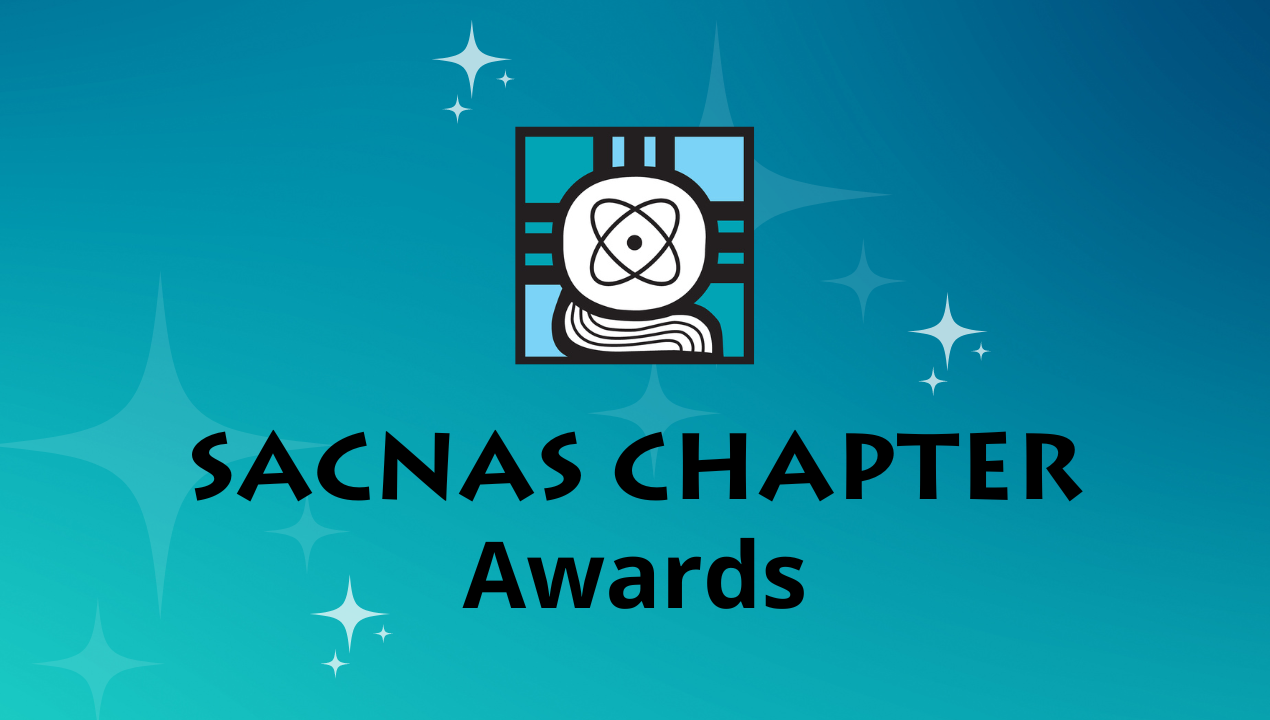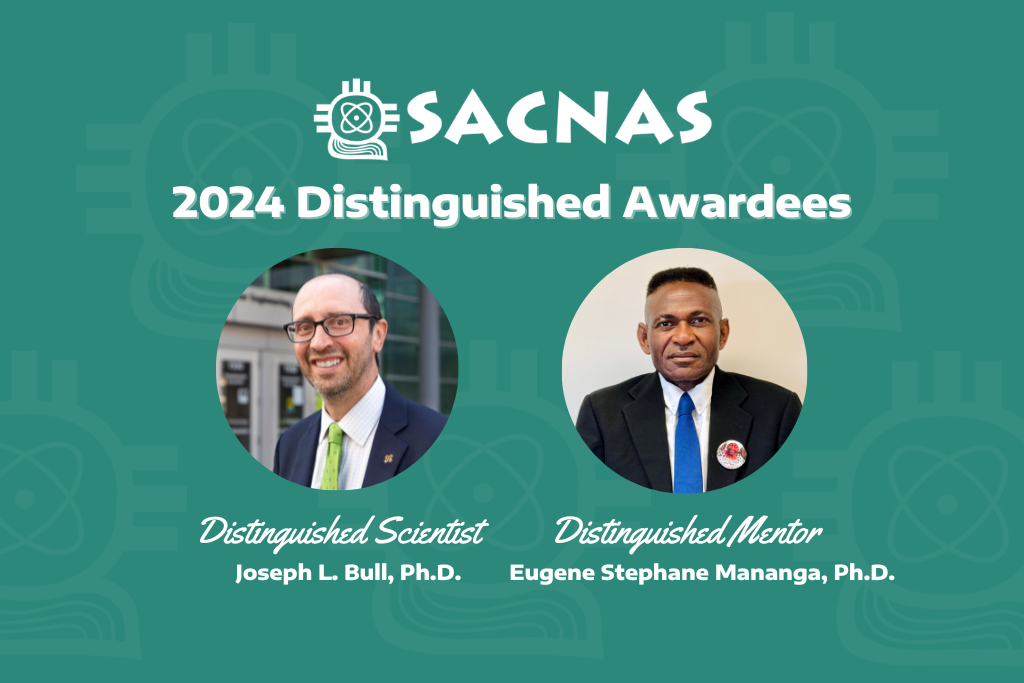Dr. Negrete (middle) after receiving award at the 2017 SACNAS conference. Left: SACNAS President Dr. Lino Gonzalez. Right: SACNAS Executive Director Dr. Antonia Franco
Exceptional SACNISTA George R. Negrete, PhD was recently honored with the SACNAS Presidential Service Award at the 2017 SACNAS conference October 19-21 in Salt Lake City, Utah for his long-term dedication to the society. Negrete, who is Professor of Chemistry at the University of Texas, San Antonio (UTSA), was selected by SACNAS President Dr. Lino Gonzalez for his significant contributions to the organization. Both Negrete and his wife, a professor of Mexican-American studies at UTSA and also a UC Santa Cruz (UCSC) alum, are Friends of the Society. Negrete’s involvement with SACNAS intensified when he served on the Board of Directors from 2003-2005. Then-President Luis Haro “twisted my arm to run. He’s had a big influence on my participation,” he says. Negrete also served on the Student Presentations and Nominations Committees.
“I enjoy making the contributions. It is not my intention to be rewarded for what I contribute, so this award comes as a humbling surprise. I do it because I think it needs to be done and I think I have some gifts that I can contribute to make some progress,” said Negrete during his Q&A with Dr. Gonzalez.
Gonzalez: How did you first get involved with SACNAS?
Negrete: I first became aware of SACNAS around 1985. I was invited to a meeting that was held in Pasadena by then-professor of Biology Dr. Frank Talamantes. I met Frank when I was a graduate student in 1984. He was one of the first faculty members who I met there, and I was a chemistry graduate student at that point. It was around 1995 when he invited Luis Haro, who became SACNAS President in the early 2000s, and me to go with him to the conference. At this time, it was a conference of mainly professionals, the academics and folks in industry and national labs, and I think that Frank was developing the kernel of the idea to bring more student involvement into SACNAS. So, Luis Haro and I participated in the SACNAS meeting and it felt like home. It was very meaningful to connect with many Chicanos in particular and Native Americans who conducted science. There were maybe 20-25 people at the conference. It was pretty small. I was lucky to be in fairly early in the expansion of SACNAS.
Gonzalez: During this time, how were you involved? Were you volunteering or just attending the conference?
Negrete: I was attending the conferences mostly as a graduate student, as a postdoc, and then as a faculty member. In those early days, I think the real expansion took place when we had the national meeting in El Paso around 1990. That’s my recollection of the first big SACNAS meeting. There were no poster presentations by students in those days. SACNAS back in those days was quite different from what it is today. It was focused mostly on professional development. There were some science talks, but mostly it was making connections between people.
Gonzalez: How has SACNAS benefited you in terms of your personal development and career? How has SACNAS influenced you?
Negrete: SACNAS has absolutely benefited me. There are challenges for Chicanos and Native Americans in academic departments. On the one hand, there’s support in academic departments, and on the other hand, there’s a pretty isolating feeling. I also think that there is at times hostility to diversity activities, lack of support, and lack of awareness. I would gather at SACNAS meetings and be refreshed as far as my energy and enthusiasm for addressing the challenges we have. Interacting with majority faculty is one of the challenges, but also challenges related to finding ways to mentor.
SACNAS is very influential with regards to connecting us with others who are in our fields in general. There’s a space for everybody at SACNAS, no matter what your field is. There’s also an important component of meeting other folks who are doing what we’re doing, and gathering advice and experience from them.
SACNAS has also helped me connect with folks who are involved in the agencies that provide funds for research and for programs, so I think I’ve benefited from that as well. I’ve felt like I’ve been much more of an insider because of my SACNAS experience than I otherwise would have been.
Gonzalez: How did you build diversity at UTSA? Did you lead these efforts?
Negrete: I wouldn’t say that I led the efforts. I’m more of a collaborative kind of person. Some of the things that were developed at UTSA were developed before we got here. We benefited from that and assumed some leadership positions because they’d already been developed. The MBRS programs that funded student training and research were developed by folks like Andy Martinez and Paul Rodriguez. Andy Sin was involved in the earlier days, as well as Dr. Manuel Barrio Sara. These are really leaders who pushed the institution at a time before Luis and I got here. I knew Luis in graduate school at UCSC, so we connected back then.
I feel connected to this regional effort to build research capabilities and training capacities in south Texas. We added to the programs that already existed both in terms of the students we trained in our labs, but also the voice we were able to put into our own departments and the college to address issues of diversifying science. I think it’s true that my connections through SACNAS were helpful in influencing the programs at my institutions and allowing me to build programs that would support Latino and Native American students.
One of my big pushes has been to utilize the development of research capacity at UTSA to increase the training capacity of all south Texas institutions. I’ve been trying to make contacts over the years and to utilize whatever resources or strengths we have to help other institutions. While getting grants in the past hasn’t always been completely successful, the contacts have been helpful in the sense that they’ve brought students into our graduate programs from those institutions.
Gonzalez: Are you originally from Texas?
Negrete: I’m originally from Southern California. I was born in Compton. It was actually never my intention to come to Texas, but it has really been an exciting place to develop a career.
Gonzalez: In the future, where would you like the society to put more emphasis on and where do you think we can grow?
Negrete: National conferences are so big and there are so many students and not enough professionals and faculty to really interact with students. I think that SACNAS has to find a way to fund a lot of mentors, or partially fund them to go to the conferences, or maybe hold other events that have closer, more intimate student and professional interactions. That’s one of the things I’d like to see, because I go to these conferences and I think many, many students don’t have close connections with the faculty who are there.
One of the things that I think is not of service to SACNAS’ mission is that we go to the conferences and the “in crowd,” the ones who are leaders end up sitting together in the front more towards the podium and the stage, and the bulk of the students are in the back and they’re not having contact with the people who they should have contact with. I must admit, it’s compelling to get together with people you see on rare occasions and exchange ideas, laugh, etc., but on the other hand, we need to connect better with the students who go. They should feel like they’ve had personal experiences with professionals that would allow them to email or make a phone call if they wanted a piece of advice. I think there’s not enough of that.
Gonzalez: What are you most proud of? What do you feel is your strongest contribution to the society?
Negrete: I was chair of the Student Presentations Committee for many years, as well as the Nominations Committee, which I’m still part of. I have to give a lot of credit to Aaron Velasco who really developed the processes for judging on the Presentations Committee. I also have to give credit to Juan Meza for putting together a document for the Nominations Committee to be able to evaluate the different candidates and subsequent committees we put numerical values on some of the criteria, and we counted up the scores for all of the nominees. I’m really pleased that in the last couple of years, we’ve been able to wrap up that process very rapidly. I think that putting scores of those has been like scoring grants at a committee at the NIH. We can focus in on the ones that are stronger to begin with. We focus more attention on those.
The other thing that I didn’t fully anticipate is that it showed all the individual committee members that we were on the same plane. We were thinking the same way because we had scored the candidates similarly. I think this gave us a lot of confidence in each other’s opinions and judgments about the candidates, and is why the processes wrapped up so quickly.
I’m really proud of how we’ve systematized that committee’s efforts so that it goes quickly and that we’ve contributed to how the nominations processes run, both the early nominations process, the voting beginning at the conference, and the Get to Know the Candidates.
Gonzalez: What keeps you coming back to the conference every year?
Negrete: Reconnecting with people who I’ve connected with over the years. I also enjoy meeting with students I haven’t ever met who I can give my two cents to about science. I’m very enthusiastic about students progressing in their scientific careers. It’s wonderful to see students who remember me. I don’t necessarily remember them, as I meet a lot of students at the SACNAS conferences. The fact that they remember who I am means that I’ve left a little bit of an impact on them, and that’s a great thing.
Gonzalez: Anything else?
Negrete: I enjoy making the contributions. It is not my intention to be rewarded for what I contribute, so this award comes as a humbling surprise. I do it because I think it needs to be done and I think I have some gifts that I can contribute to make some progress. I’ve worked very hard doing the things that I’ve done for SACNAS, but my satisfaction about it is really the contribution that it makes to the organization. That’s what drives me.



